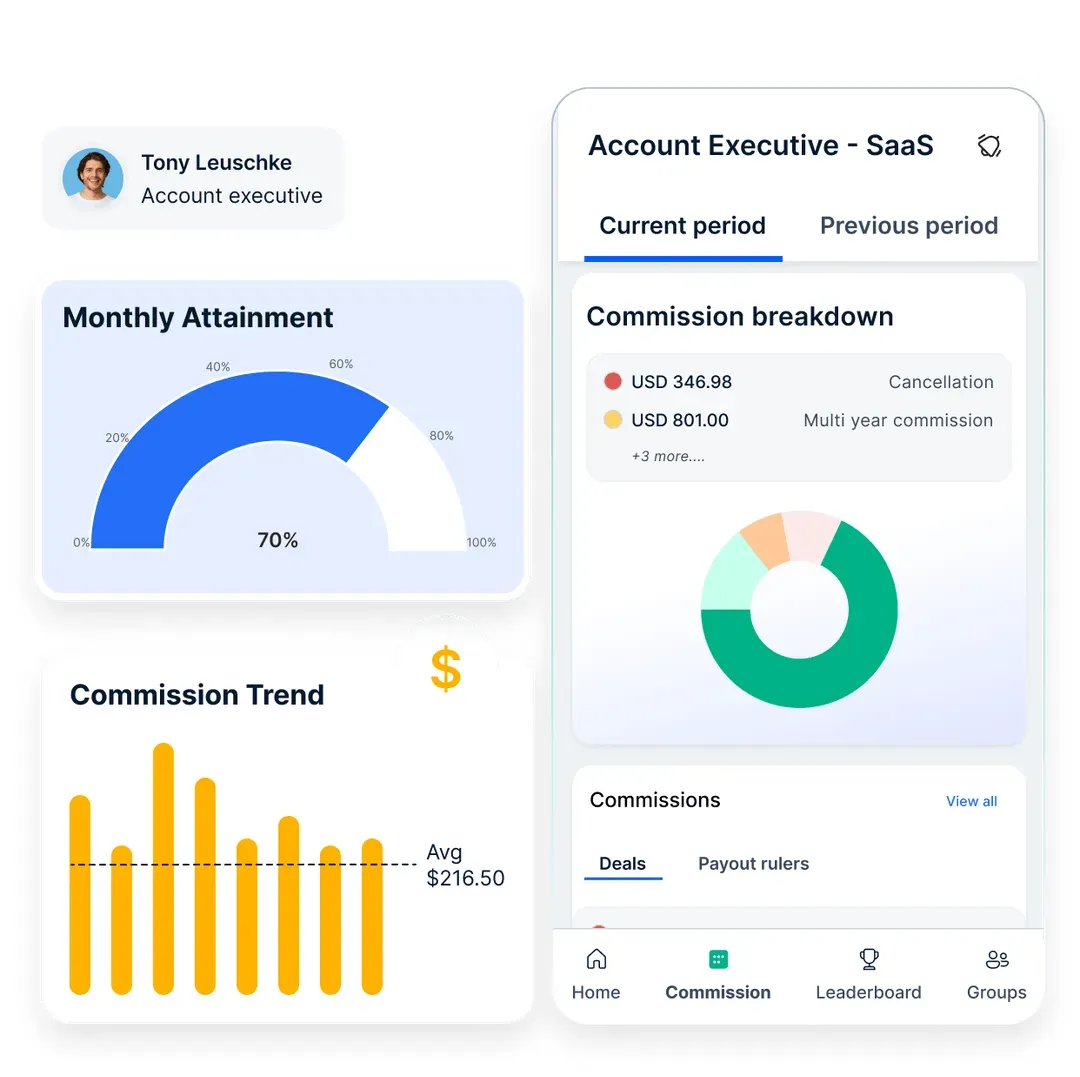Sales OKRs: A Guide to Setting and Achieving Sales Objectives and Key Results
Sales success isn’t just about hitting quotas—it’s about setting the right objectives and tracking measurable results. In this guide, learn how to create Sales OKRs that align your team’s goals with business growth, ensuring focus, accountability, and continuous progress.
On this page
Setting clear and measurable goals is essential for driving sales success. Research shows that companies with well-defined goals are 10 times more likely to achieve significant outcomes compared to those without structured goals. This is where OKRs—Objectives and Key Results—come into play.
By providing a structured framework for goal-setting, OKRs help sales teams align their efforts with broader business objectives, stay focused, and measure their progress effectively. In fact, organizations using OKRs have reported a 21% increase in productivity and a 32% improvement in employee engagement.
In this blog, we'll explore the essentials of Sales OKRs, how to set and implement them and share practical examples to help you get started. Whether you're a sales manager or a team member, this guide will equip you with the tools to boost your sales performance through well-crafted OKRs.
Understanding sales OKRs
OKRs, which stand for Objectives and Key Results, are a goal-setting framework that has gained popularity for its simplicity and effectiveness. The concept originated in the 1970s at Intel and has since been adopted by many leading companies, including Google, LinkedIn, and Twitter.
In sales, OKRs (Objectives and Key Results) are a strategic framework used to set, communicate, and monitor goals and results within a sales team. The main components of Sales OKRs are:
- Objectives: These are high-level, qualitative goals that the sales team aims to achieve. Objectives should be ambitious, inspirational, and clearly defined to provide a clear direction for the team. They answer the question: "What do we want to accomplish?"
- Key Results: These are specific, measurable outcomes that help track the progress towards achieving the objectives. Key results should be quantifiable and time-bound, answering the question: "How will we measure success in achieving the objective?"
The importance of sales OKRs
Sales OKRs play a crucial role in ensuring that the sales team's efforts are aligned with the company's strategic goals. Here are some key reasons why Sales OKRs are important:
- Aligning sales goals with business objectives: Sales OKRs ensure that the goals of the sales team are directly aligned with the broader objectives of the business. This alignment helps in driving the overall strategy and achieving the company's long-term goals.
- Driving focus and accountability: By setting specific and measurable OKRs, sales teams can stay focused on what matters most. This focus helps in avoiding distractions and ensures that all efforts are directed towards achieving the set objectives. Moreover, OKRs promote accountability as each team member understands their role in achieving the goals.
- Enhancing performance and motivation: Clear and challenging objectives motivate sales teams to perform at their best. The transparency and regular tracking associated with OKRs help in recognizing achievements and addressing issues promptly, thus enhancing overall performance.
- Facilitating continuous improvement: Sales OKRs provide a framework for continuous improvement. By regularly reviewing and updating OKRs, sales teams can adapt to changing market conditions, learn from their experiences, and continuously improve their strategies and performance.
Types of sales OKRs
Sales OKRs can be categorized into several types, each focusing on different aspects of the sales process. Understanding these types can help in setting more targeted and effective OKRs. Here are some common types of Sales OKRs:
- Revenue-based OKRs: These OKRs focus on increasing the sales revenue. Examples include objectives related to overall revenue growth, achieving specific sales targets, or increasing the average deal size.
- Customer-based OKRs: These are aimed at acquiring and retaining customers. They can include objectives related to customer satisfaction, customer acquisition, retention rates, or expanding the customer base.
- Product-based OKRs: These OKRs are related to specific products or services. Objectives may include increasing the sales of a particular product, launching a new product successfully, or improving product features based on customer feedback.
- Process-based OKRs: Targeting improvements in sales processes and efficiency. Examples include objectives related to reducing the sales cycle length, improving lead conversion rates, or enhancing the efficiency of the sales funnel.
- Team-based OKRs: Goals set for individual sales teams or regions. These can focus on team performance, collaboration, training, and development, or achieving specific regional targets.
15 Examples of sales OKRs
To help you get started, here are 15 examples of Sales OKRs with detailed descriptions that you can adapt to your own team’s needs:
1. Objective: Increase quarterly sales revenue.
Focus on driving higher revenue within the quarter by boosting overall sales performance and closing more deals. This involves identifying key opportunities for revenue growth, leveraging sales strategies to maximize deal sizes, and ensuring consistent follow-through on leads.
- Key Result 1: Achieve $500,000 in sales revenue.
- Key Result 2: Close 50 new deals.
- Key Result 3: Increase average deal size by 10%.
2. Objective: Improve customer retention.
Enhance customer loyalty and satisfaction to reduce churn and increase long-term value. This can be achieved by improving customer service, offering personalized experiences, and addressing any issues promptly to ensure customers remain satisfied and loyal.
- Key Result 1: Increase customer renewal rate to 85%.
- Key Result 2: Reduce churn rate by 5%.
- Key Result 3: Implement a customer loyalty program with 100 active participants.
3. Objective: Expand market share.
Capture a larger portion of the market by acquiring new customers and increasing the presence in targeted regions. This may involve entering new geographic areas, targeting specific customer segments, and launching marketing campaigns to raise brand awareness.
- Key Result 1: Acquire 100 new customers in the target market.
- Key Result 2: Increase market share by 5%.
- Key Result 3: Conduct 10 market penetration campaigns.
4. Objective: Enhance sales team productivity.
Boost the efficiency and effectiveness of the sales team through better tools, training, and streamlined processes. By reducing time spent on administrative tasks and improving sales techniques, the team can focus more on selling and closing deals.
- Key Result 1: Increase sales call volume by 20%.
- Key Result 2: Reduce sales cycle length by 15%.
- Key Result 3: Implement a new CRM system with 90% adoption rate.
5. Objective: Boost product sales.
Drive higher sales for specific products by targeting key customer segments and promoting product benefits. This can include running targeted marketing campaigns, offering promotions, and educating customers on the unique value of the product.
- Key Result 1: Increase product X sales by 25%.
- Key Result 2: Conduct 5 product webinars with 200 attendees each.
- Key Result 3: Achieve a 30% upsell rate for product X.
6. Objective: Improve lead generation.
Generate a higher volume of quality leads to feed the sales pipeline and drive future growth. This involves implementing lead generation strategies, optimizing marketing efforts, and ensuring leads are effectively nurtured and converted.
- Key Result 1: Generate 1,000 new leads.
- Key Result 2: Increase lead conversion rate to 20%.
- Key Result 3: Implement an automated lead nurturing campaign.
7. Objective: Strengthen customer relationships.
Foster deeper connections with customers to enhance satisfaction, loyalty, and long-term engagement. Building strong relationships involves understanding customer needs, providing exceptional service, and proactively addressing any issues.
- Key Result 1: Increase customer satisfaction score to 90%.
- Key Result 2: Conduct 50 customer feedback interviews.
- Key Result 3: Resolve customer complaints within 24 hours.
8. Objective: Enhance sales training and development.
Invest in the skills and knowledge of the sales team to improve overall performance and capability. Continuous training and development ensure that sales representatives are equipped with the latest techniques and knowledge to excel in their roles.
- Key Result 1: Conduct 10 sales training sessions.
- Key Result 2: Achieve 80% sales team certification rate.
- Key Result 3: Improve sales team performance by 15%.
9. Objective: Increase cross-sell and upsell opportunities.
Identify and capitalize on opportunities to sell additional products or services to existing customers. This involves understanding customer needs, training the sales team on cross-selling and upselling techniques, and integrating these strategies into the sales process.
- Key Result 1: Identify 50 cross-sell opportunities.
- Key Result 2: Increase upsell revenue by 20%.
- Key Result 3: Train the sales team on cross-sell and upsell strategies.
10. Objective: Optimize sales processes.
Streamline and improve sales processes to enhance efficiency and reduce administrative burdens. By implementing automation tools and refining workflows, the sales team can focus more on strategic activities that drive revenue.
- Key Result 1: Reduce administrative tasks by 25%.
- Key Result 2: Implement a sales automation tool with 80% usage rate.
- Key Result 3: Increase sales process efficiency by 30%.
11. Objective: Expand into new regions.
Grow the business by entering new geographic markets and acquiring new customers in those areas. This can involve market research, developing region-specific strategies, and establishing a local presence to better serve new customers.
- Key Result 1: Enter 3 new geographic markets.
- Key Result 2: Acquire 200 new customers in new regions.
- Key Result 3: Achieve $1 million in sales revenue from new regions.
12. Objective: Improve sales forecasting accuracy.
Enhance the precision of sales forecasts to better plan and allocate resources. Accurate forecasting helps in managing inventory, budgeting, and setting realistic sales targets.
- Key Result 1: Achieve 90% accuracy in sales forecasts.
- Key Result 2: Implement a new sales forecasting tool.
- Key Result 3: Train the sales team on forecasting best practices.
13. Objective: Increase digital sales.
Boost online sales channels to capture the growing digital market and reach more customers. This involves optimizing the online sales platform, running digital marketing campaigns, and improving the customer’s online shopping experience.
- Key Result 1: Increase online sales revenue by 40%.
- Key Result 2: Improve website conversion rate to 15%.
- Key Result 3: Launch 3 digital marketing campaigns.
14. Objective: Enhance sales team collaboration.
Foster better teamwork and communication within the sales team to drive collective success. Effective collaboration ensures that team members share knowledge, support each other, and work together towards common goals.
- Key Result 1: Implement a team collaboration tool.
- Key Result 2: Conduct weekly team meetings with 100% attendance.
- Key Result 3: Increase inter-team project completion rate by 20%.
15. Objective: Improve customer acquisition cost (CAC).
Reduce the cost of acquiring new customers while maintaining or improving acquisition rates. This involves optimizing marketing spend, leveraging cost-effective strategies, and enhancing the overall efficiency of the customer acquisition process.
- Key Result 1: Reduce CAC by 10%.
- Key Result 2: Increase referral program participation by 30%.
- Key Result 3: Implement cost-effective lead generation strategies.
Implementing sales OKRs
Implementing Sales OKRs effectively involves a structured approach to ensure alignment, engagement, and continuous improvement. Here are the key steps:
- Creating a sales OKR plan: Develop a comprehensive plan that outlines the objectives, key results, timelines, and responsibilities. This plan should be communicated clearly to the entire sales team.
- Involving the sales team: Engage the sales team in the OKR-setting process to ensure buy-in and commitment. Encourage team members to contribute their insights and align personal goals with the team’s objectives.
- Tools and software: Utilize tools and software to track and manage Sales OKRs. Platforms like OKR software, CRM systems, and project management tools can help in monitoring progress and facilitating collaboration.
- Training and support: Provide training and ongoing support to the sales team to ensure they understand how to set and achieve OKRs. This includes training on using the tools and understanding the OKR framework.
- Regular check-ins: Schedule regular check-ins to review progress, address challenges, and make necessary adjustments. These check-ins can be weekly or bi-weekly, depending on the team's needs and the complexity of the objectives.
- Feedback and recognition: Encourage open feedback and recognize achievements. Celebrate milestones and successes to keep the team motivated and focused on their goals.
- Continuous improvement: Use the insights gained from the OKR process to improve future planning and implementation. Adjust strategies based on what worked well and what didn’t to continuously enhance the effectiveness of your Sales OKRs.
By following these steps, you can ensure that your Sales OKRs are implemented effectively, driving alignment, engagement, and success across the sales team.
Monitoring and reviewing sales OKRs
Regularly monitoring and reviewing Sales OKRs is essential to ensure they remain relevant and achievable. This process involves tracking progress, making adjustments as needed, and celebrating successes to maintain motivation and alignment.
- Regular check-ins: Schedule frequent check-ins, such as weekly or bi-weekly meetings, to review progress on OKRs. These meetings should involve the sales team and key stakeholders to discuss achievements, challenges, and next steps.
- Using data and metrics: Utilize data and metrics to objectively assess progress toward key results. Sales analytics tools, CRM systems, and other reporting mechanisms can provide valuable insights into performance.
- Adjusting OKRs as needed: Be flexible and willing to adjust OKRs if necessary. Market conditions, business priorities, and unforeseen challenges can require modifications to ensure objectives remain realistic and attainable.
- Feedback and collaboration: Encourage open feedback and collaboration during reviews. Team members should feel comfortable sharing their insights and suggestions for improving OKR outcomes.
- Celebrating successes: Recognize and celebrate milestones and achievements. Acknowledging successes boosts morale and reinforces the value of setting and achieving OKRs.
- Continuous improvement: Use the insights gained from monitoring and reviewing OKRs to inform future goal-setting processes. Learn from what worked well and identify areas for improvement to enhance the effectiveness of your Sales OKRs over time.
Effective monitoring and reviewing of Sales OKRs ensure that the sales team stays on track, remains motivated, and continuously improves their performance.
Success stories of companies that have implements OKRs
Some success stories in sales OKRs are as follows:
1. Google
Successful companies like Google have used OKRs since 1999, which helped them grow from 40 to 60,000 employees.
Google has long relied on the OKR framework because it delivers remarkable results. They set ambitious objectives and grade their key results on a scale of 0 to 1.0 at the end of each quarter.
Google firmly believes in the transparency of OKRs, allowing everyone to see what others are working on. They consider OKRs scored between 0.6 and 0.7 as successful, indicating ambitious goals. If someone consistently scores 1.0, it suggests their goals are not challenging enough.
Google also views low-grade OKRs as valuable, using them as data to inform the OKRs for the next quarter.
2. LinkedIn
LinkedIn also utilizes OKRs, a framework that has significantly contributed to its rapid growth into a $20 billion company.
The CEO of LinkedIn, Jeff Weiner, emphasizes the importance of providing clear direction to business leaders, as achieving the best outcomes requires a clear vision and mission.
According to Weiner, a good leader can elevate the entire team through coaching, strategic guidance, defining clear objectives, and measuring results. He believes that OKRs should be ambitious and time-bound, motivating the entire team to set challenging goals. Weiner recommends setting 3 to 5 OKRs per quarter.
To track the progress of OKRs, Weiner holds a weekly three-hour meeting with employees and a full-day meeting once a month. These meetings are designed to keep him updated on how employees are working towards business objectives. During these sessions, employees share their achievements from the previous week, helping them stay focused and continue their productive efforts at LinkedIn.
3. Huawei
Huawei, one of the largest telecom companies in the world, transitioned from the traditional KPI strategy to OKRs to elevate their business success.
Huawei initially used the KPI system to track business success. However, it wasn't as effective for them because the KPI system focuses on goal setting as the starting point and performance evaluation as the endpoint, without providing a clear understanding of the value of those goals to their employees.
In 2023, Huawei decided to adopt OKRs after realizing that many organizations successfully achieved their objectives using this methodology. With OKRs, they were able to set achievable goals within a specific timeframe. This approach significantly improved their business performance by aligning all employees to work together towards common business goals.
Tracking sales OKRs with Compass: Real-time insights, gamification & motivation

Setting ambitious Sales OKRs is one thing—keeping your team aligned, engaged, and consistently working toward them is another. Without real-time visibility and motivation, OKRs can easily turn into another checkbox rather than a true driver of performance.
That’s where Compass transforms the game. By integrating AI-powered tracking, gamification, and automated incentives, Compass ensures that Sales OKRs become a living, breathing part of your sales culture.
Turn OKRs into a motivation engine

Sales teams perform best when they have clear visibility of their goals and a structured path to success. Compass provides:
✅ Live performance dashboards: Give reps a real-time view of their progress toward OKRs, ensuring transparency, accountability, and continuous motivation.✅ Gamified goals & sales contests: Make OKRs exciting with leaderboards, race-themed challenges, and team competitions that turn targets into friendly rivalries.✅ Instant recognition & incentives: Reward milestone achievements, reinforce winning behaviors, and align compensation with OKR progress, keeping reps engaged.✅ Data-driven coaching & insights: Track sales trends, spot areas for improvement, and adjust targets dynamically to keep performance on track.
Create a culture of achievement
With Compass, Sales OKRs become more than just targets—they become stepping stones to high performance. Instead of waiting for end-of-quarter reports, reps and managers get real-time feedback, allowing immediate course correction and motivation boosts.
A motivated, goal-driven team doesn’t just hit OKRs—they exceed them. Ready to turn your Sales OKRs into a powerful force for success? Compass makes it happen. 🚀
How a beverage brand transformed sales performance with Compass
An omnichannel chai and coffee brand, serves millions of customers daily across multiple touchpoints like retail stores, cloud kitchens, and corporate offices.
With a large business development team and distribution network spread across 43 major cities, managing sales performance and incentive programs was becoming increasingly complex and inefficient.
The manual process of tracking sales performance and calculating commissions caused delays in payouts and a lack of transparency for the sales team.
The challenge: Chaipoint’s incentive programs for retailers and distributors were heavily reliant on manual tracking of consumption data, machine deployments, and other variables like security deposits and maintenance charges. Without a centralized system, the sales team lacked visibility into their performance, and delays in commission payouts were common due to multiple factors and team involvement.
Solution: Chaipoint implemented Compass’s sales performance management solution to tackle these challenges:
- Enhanced visibility: Sales teams and distributors were given real-time access to their performance, targets, and incentive calculations, improving transparency and engagement.
- Streamlined commission calculations: Complex variables in the incentive programs were simplified, making commission calculations more transparent and easy to understand.
- Automated processes: Compass automated the entire sales performance tracking process, eliminating delays in payout disbursement and providing real-time data for better decision-making.
Results:
- 200% increase in incentive payouts in less than six months.
- 115% growth in incentive qualifiers in six months.
- 4% increase in consumption revenue quarter-on-quarter.
- 40% rise in machine deployments within six months.
By implementing Compass, Chaipoint was able to create an efficient and transparent sales performance management system that motivated their teams and drove significant improvements in sales outcomes.
Looking to simplify your sales performance management? Discover how Compass can help you build transparent and efficient sales commission programs to drive growth.
Conclusion
Sales OKRs are a powerful tool for setting clear, measurable goals that drive sales performance and align team efforts with broader business objectives. By understanding the fundamentals of OKRs, the importance of aligning them with business goals, and the various types of Sales OKRs, you can effectively implement this framework within your sales team.
Remember to set SMART objectives and measurable key results, involve your sales team in the process, and regularly monitor and review progress. By addressing common challenges and learning from real-life examples, you can overcome obstacles and drive continuous improvement.
Incorporating Sales OKRs into your goal-setting strategy not only enhances focus and accountability but also boosts productivity and motivation. Start setting and implementing Sales OKRs today to unlock your team's full potential and achieve outstanding sales success.
FAQs
1. What are Sales OKRs?
Sales OKRs (Objectives and Key Results) are a goal-setting framework designed to help sales teams set clear, measurable objectives and track their progress towards achieving them. The objectives are ambitious and qualitative, while the key results are specific and quantifiable.
2. How do Sales OKRs differ from other goal-setting methods?
Sales OKRs differ from other goal-setting methods by their emphasis on measurable outcomes and alignment with broader business goals. They focus on setting ambitious yet achievable objectives and tracking specific, quantifiable results to measure progress. This method promotes transparency, accountability, and continuous improvement.
3. How often should Sales OKRs be reviewed?
Sales OKRs should be reviewed regularly, typically on a weekly or bi-weekly basis. Regular check-ins allow teams to track progress, address challenges, and make necessary adjustments to stay on course.
4. What are the best tools for managing Sales OKRs?
There are several tools available for managing Sales OKRs, including OKR software like Workfront, Gtmhub, and Ally.io. Additionally, CRM systems such as Salesforce, HubSpot, and project management tools like Asana and Trello can help in tracking progress and facilitating collaboration.
5. Can Sales OKRs be adjusted mid-cycle?
Yes, Sales OKRs can be adjusted mid-cycle if necessary. Flexibility is essential to adapt to changing market conditions, business priorities, or unforeseen challenges. Regular reviews help identify when adjustments are needed to ensure objectives remain realistic and attainable.
6. How do you ensure team buy-in for Sales OKRs?
Ensuring team buy-in for Sales OKRs involves engaging the sales team in the OKR-setting process, clearly communicating the benefits, and providing comprehensive training. Involving team members in creating OKRs increases ownership and commitment. Recognizing and rewarding achievements also fosters a positive attitude towards OKRs.
7. What should be the frequency of setting Sales OKRs?
Sales OKRs are typically set on a quarterly basis. This timeframe is long enough to achieve significant results but short enough to remain flexible and responsive to changes. However, some organizations may also set annual OKRs for long-term goals, with quarterly OKRs acting as stepping stones.
8. How do Sales OKRs contribute to overall business growth?
Sales OKRs contribute to overall business growth by aligning sales efforts with the company's strategic objectives. This alignment ensures that sales activities directly support business goals, driving revenue growth, market expansion, and improved customer satisfaction. Additionally, the focus on measurable results enhances accountability and performance.
9. What is the role of leadership in the success of Sales OKRs?
Leadership plays a crucial role in the success of Sales OKRs by providing direction, support, and resources. Leaders must actively engage in the OKR process, communicate the importance of OKRs to the team, and foster a culture of transparency and accountability. Their commitment and involvement are vital in motivating the sales team and ensuring the effective implementation of OKRs.













